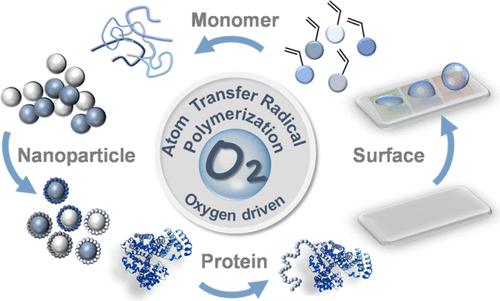氧驱动原子转移自由基聚合
IF 15.6
1区 化学
Q1 CHEMISTRY, MULTIDISCIPLINARY
引用次数: 0
摘要
在传统的原子转移自由基聚合(ATRP)中,由于氧具有淬灭自由基和停止聚合过程的倾向,因此必须谨慎地消除氧。此外,氧会氧化价较低的Cu催化剂,影响其激活烷基卤化物和聚合的能力。在这项研究中,我们提出了一种利用烷基硼烷化合物的氧驱动ATRP,这种方法不仅避免了严格的除氧需要,而且利用氧作为促进聚合的必要辅助因子。该方法在有机或水介质中表现出广泛的相容性,产生具有低分散性(Đ低至1.11)和分子量与理论值密切一致的定义良好的聚合物。三乙基硼烷(Et3B)及其空气稳定的三乙基硼烷-胺配合物(Et3B- dmap)有助于在露天条件下控制聚合,证明了对各种单体的效率。此外,该技术能够成功合成蛋白质-聚合物偶联物,并支持纳米颗粒和硅片在有氧条件下的表面修饰。这种氧驱动的ATRP代表了一个强大的、多功能的精密聚合平台,在材料科学、生物医学和高级表面工程方面具有深远的意义。本文章由计算机程序翻译,如有差异,请以英文原文为准。

Oxygen-Driven Atom Transfer Radical Polymerization
In traditional atom transfer radical polymerization (ATRP), oxygen must be meticulously eliminated due to its propensity to quench radical species and halt the polymerization process. Additionally, oxygen oxidizes the lower-valent Cu catalyst, compromising its ability to activate alkyl halides and propagate polymerization. In this study, we present an oxygen-driven ATRP utilizing alkylborane compounds, a method that not only circumvents the need for stringent oxygen removal but also exploits oxygen as an essential cofactor to promote polymerization. This approach exhibits broad compatibility in organic or aqueous media, yielding well-defined polymers with low dispersity (Đ as low as 1.11) and molecular weights closely aligned with theoretical values. Triethylborane (Et3B) and its air-stable triethylborane-amine complex (Et3B-DMAP) facilitate controlled polymerization under open-to-air conditions, demonstrating efficiency across a wide range of monomers. Moreover, the technique enables the successful synthesis of protein–polymer conjugates and supports surface modifications of nanoparticles and silicon wafers under aerobic conditions. This oxygen-driven ATRP represents a robust and versatile platform for precision polymerization with far-reaching implications in materials science, biomedicine, and advanced surface engineering.
求助全文
通过发布文献求助,成功后即可免费获取论文全文。
去求助
来源期刊
CiteScore
24.40
自引率
6.00%
发文量
2398
审稿时长
1.6 months
期刊介绍:
The flagship journal of the American Chemical Society, known as the Journal of the American Chemical Society (JACS), has been a prestigious publication since its establishment in 1879. It holds a preeminent position in the field of chemistry and related interdisciplinary sciences. JACS is committed to disseminating cutting-edge research papers, covering a wide range of topics, and encompasses approximately 19,000 pages of Articles, Communications, and Perspectives annually. With a weekly publication frequency, JACS plays a vital role in advancing the field of chemistry by providing essential research.

 求助内容:
求助内容: 应助结果提醒方式:
应助结果提醒方式:


